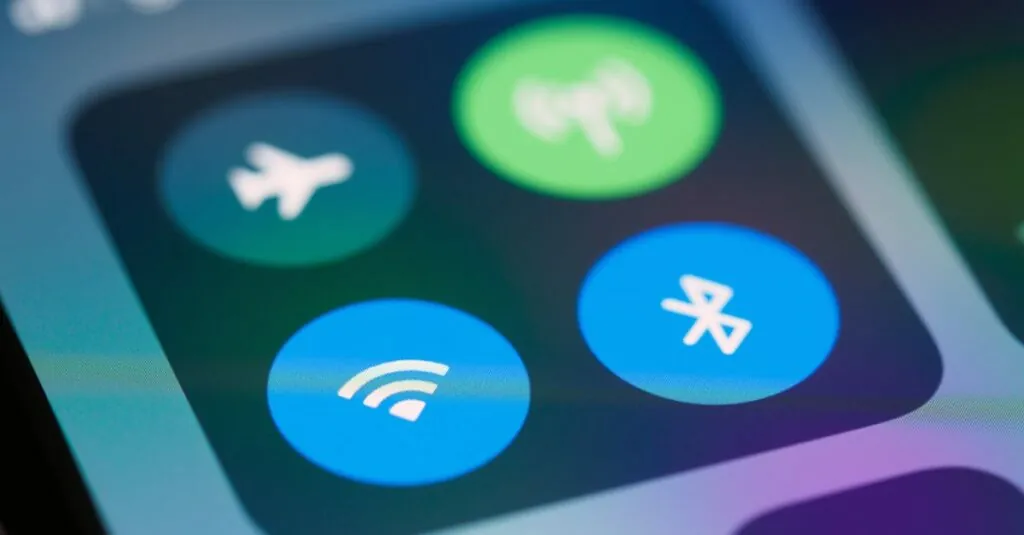Table of Contents
ToggleIn a world where mobile phones have become an extension of our very selves, it’s hard to imagine life without them. From snapping selfies to navigating the nearest taco truck, these pocket-sized wonders pack a punch with features that cater to every whim. But with so many options out there, how does one choose the perfect device?
Overview of Mobile Phone Features
Mobile phones offer a range of essential features that enhance user experience. Camera quality stands out as a top priority for many users. High-resolution cameras with multiple lenses enable stunning photography. Battery life plays a crucial role in daily usability. Devices with long-lasting batteries support extended usage without frequent recharging.
Display quality significantly impacts viewing experiences. OLED and AMOLED screens deliver vibrant colors and sharp details. Connectivity options such as 5G and Wi-Fi 6 ensure fast internet access, which is vital for streaming and online gaming. Storage capacity offers room for apps, photos, and videos. Devices with expandable memory provide flexibility for users with large media libraries.
Security features are becoming increasingly important. Biometrics like facial recognition and fingerprint sensors add layers of protection. User interfaces, or UIs, vary significantly across brands. Intuitive UIs improve navigation and overall satisfaction. Durability also factors into purchasing decisions. Water-resistant devices withstand everyday challenges.
Performance specifications are vital too. Processors with multiple cores handle multitasking efficiently. RAM size affects how well apps run simultaneously, with higher RAM allowing smoother performance. Operating systems such as Android and iOS host a variety of applications and customizations. Regular software updates enhance functionality and security.
Ergonomics contribute to user comfort. Sleek designs fit comfortably in hands while remaining aesthetically pleasing. Price points vary widely, catering to different budgets. Users can find devices that meet their specific needs, whether they seek high-end features or basic functionality.
Design and Build Quality
Design and build quality significantly influence user experience with mobile phones. A well-constructed device not only enhances durability but also improves overall functionality.
Material and Durability
Materials used in mobile phones impact their longevity. Manufacturers typically use metal, glass, or plastic for construction. Metal bodies provide superior durability and premium feel, while glass adds elegance. Certain devices feature Gorilla Glass for scratch resistance, enhancing their lifespan. Plastic, although lighter and more affordable, may sacrifice durability. In terms of water resistance, many phones achieve IP ratings, indicating their ability to withstand moisture and dust. This rating helps users select devices that endure everyday wear and tear with confidence.
Ergonomics and Aesthetics
Ergonomics matter when using a mobile phone for extended periods. Devices designed with curved edges and lightweight materials fit comfortably in hand. Additionally, button placement affects ease of use. A well-positioned fingerprint sensor simplifies unlocking, improving accessibility. Aesthetically, color options significantly influence user preference. Shades like matte black and vibrant blue attract different demographics. Overall, sleek designs not only look appealing but also contribute to the device’s handling and comfort during daily tasks.
Display Technology
Display technology plays a vital role in delivering an optimal user experience, particularly in mobile phones. Many factors come together to create vibrant and clear visuals that enhance usability.
Screen Types and Resolutions
LCD, OLED, and AMOLED represent the main screen types utilized in mobile devices. LCDs provide decent brightness and color reproduction, though they may lack the deep blacks offered by OLED. AMOLED screens deliver more vivid colors and improved contrast, making them ideal for media consumption. Resolutions like Full HD (1920 x 1080) and Quad HD (2560 x 1440) ensure sharp images, while 4K displays cater to premium devices, offering enhanced detail. Higher pixel densities contribute to a more immersive viewing experience, particularly in gaming and video streaming.
Brightness and Color Accuracy
Brightness levels significantly impact outdoor visibility. Many top-tier smartphones reach peak brightness levels of 800 nits or higher, ensuring usability in bright sunlight. Color accuracy, measured by metrics like Delta E, indicates how closely colors displayed match real-life counterparts. Devices achieving a Delta E close to 1 provide exceptional fidelity. Moreover, features like HDR (High Dynamic Range) enhance contrast and color range, delivering lifelike visuals in supported content. Investing in a phone with strong brightness and color performance enhances overall enjoyment, particularly for photographers and video enthusiasts.
Camera Capabilities
Camera capabilities significantly enhance the mobile phone experience, focusing on quality and usability. Understanding these features helps consumers choose devices suited to their photography needs.
Megapixels and Sensor Quality
Megapixels indicate image resolution, influencing the detail captured in photos. Higher megapixel counts often result in sharper images, but sensor quality plays a crucial role in overall performance. Larger sensors capture more light, improving low-light photography. Some phones feature multi-lens setups, allowing for versatile shots with various focal lengths. Users benefit from advanced technologies like optical image stabilization, which reduces blurriness. Top devices may utilize specialized sensors, achieving remarkable clarity and rich colors.
Additional Features and Modes
Additional features and modes expand photography options and user creativity. Portrait mode enhances subject focus, creating a pleasing bokeh effect in backgrounds. Night mode improves low-light shooting, utilizing multiprocessor systems to enhance dark scenes without unwanted noise. Advanced software capabilities include AI enhancements for scene recognition and automatic adjustments to settings. Editing tools often come embedded, allowing users to fine-tune their images before sharing. Many smartphones also offer 4K video recording, elevating captured moments to cinematic quality. These features allow users to capture impressive images and videos easily.
Performance and Software
Performance and software significantly impact the overall user experience on mobile phones. Users benefit from powerful processors and ample RAM, ensuring smooth multitasking and high-speed operations.
Processor and RAM Specifications
Processor and RAM specifications play key roles in determining mobile performance. Latest Snapdragon and Apple A-series processors support demanding applications and gaming, ensuring responsiveness and efficiency. In general, devices with 6GB or more RAM handle multitasking effortlessly, allowing users to switch between apps seamlessly. Phones equipped with octa-core processors can manage intensive tasks better, delivering fluid experiences during gaming or video streaming.
Operating System and User Experience
Operating systems like Android and iOS shape user experience through features and interfaces. Android allows customization with various skins and widgets, catering to different preferences. In contrast, iOS offers a streamlined experience, emphasizing simplicity and security. Both systems receive frequent updates, enhancing functionality and performance over time. User experience also benefits from features like dark mode and gesture navigation, providing intuitive interactions.
Battery Life and Charging Options
Battery life and charging options are crucial when choosing a mobile phone. Extended battery capacity ensures devices support daily activities without frequent recharging.
Battery Capacity and Longevity
Battery capacity, measured in milliampere-hours (mAh), directly affects longevity. A higher mAh rating often means longer usage times. For instance, smartphones with 4500 mAh batteries typically last more than a full day with moderate use. In comparison, devices with 3000 mAh batteries may need a midday charge, especially with heavy usage. Optimized software also plays a role in battery efficiency. Manufacturers often enhance battery longevity through power-saving modes and adaptive brightness settings, helping users maximize their device’s usage time in daily scenarios.
Fast Charging and Wireless Charging
Fast charging technology allows users to charge devices quickly, significantly reducing downtime. Many leading brands now feature fast charging options, offering 50% charge in as little as 30 minutes. Wireless charging adds convenience, eliminating the need for cables. Standards like Qi enable compatibility across many devices, simplifying charging setups at home and public spaces. Charging pads and stands enhance the user experience by providing easy access while using devices. Some phones support both fast and wireless charging, giving users flexibility in how they power their devices.
Choosing the right mobile phone involves careful consideration of various features that enhance usability and performance. Users should prioritize aspects like camera quality battery life and display technology to ensure a satisfying experience. Understanding the importance of connectivity options and robust security features can make a significant difference in daily usage.
Additionally the design and build quality shouldn’t be overlooked as they contribute to both aesthetics and durability. With a multitude of choices available across different price points it’s essential for users to identify their specific needs and preferences. By doing so they can select a device that not only meets their requirements but also enriches their mobile experience.







